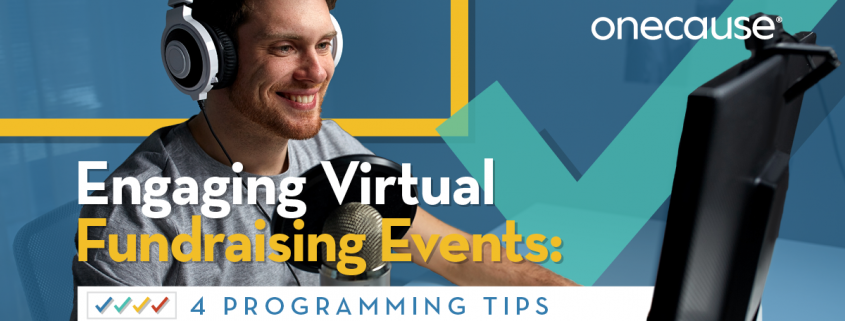Engaging Virtual Fundraising Events: 4 Programming Tips
Your nonprofit is always on the lookout for ways to step up your donor engagement and bring in more revenue. You’ve likely hosted a variety of in-person events before, but have you considered taking the entire fundraising process online?
Virtual fundraising is one of the most powerful strategies at nonprofits’ disposal. With virtual fundraising, your nonprofit isn’t bound by geographic barriers, giving you the ability to grow your reach and revenue. Plus, by understanding how to run a virtual event experience, you can easily conduct hybrid events, empowering you to engage two audiences at once.
To realize these benefits and many more, your nonprofit’s team will need to dedicate ample time to planning your virtual fundraising event. After all, it’s important to be intentional about how you will keep supporters engaged and laser-focused on your mission when they’re on a screen. However, with the right tools and strategies, you’ll be well-prepared to design an unforgettable virtual experience that will strengthen donor relationships and boost revenue.
Use these top programming tips to make your next virtual fundraising event the best one yet:
- Plan early and conduct several test runs
- Keep your program short and sweet
- Centralize the virtual event experience
- Schedule your activities strategically
An effective virtual event will keep current supporters invested in your cause and help new ones see the value in supporting your organization over time. Time to dive in!
1. Plan early and conduct several test runs.
To help supporters feel immersed in your event, you need to leverage a comprehensive online fundraising solution with livestreaming capabilities. Livestreaming allows your attendees to engage with your organization in real time and feel like they’re connected to your community, even if they’re miles apart.
To shape your livestream programming, it’s critical that you plan early and determine exactly what this will look like from a supporter’s perspective. Make sure it’s easy to sign up for and participate in the event.
For example, ask yourself the following questions:
- Will your virtual event occur alongside an in-person event? If so, what will your remote supporters see at times when your virtual and in-person activities aren’t in sync?
- Will you play any pre-recorded videos during your livestream? What will these videos show and how will they keep supporters’ attention?
- Will you create breakout rooms or allow supporters to speak in a live chat to create a sense of community?
- What other engagement tactics will you use throughout your livestream?
In addition to considering what you’ll show during your livestream, you also need to make sure you have all your technical bases covered so your program can go off without a hitch. After all, nothing turns off a supporter more than a virtual experience with lags or technical difficulties, which can quickly lead to supporters getting distracted or clicking off your livestream altogether.
Make sure to lead several test runs with your virtual event staff and volunteers. Essentially, this is like a dress rehearsal before the big show! Test your technology and request that your team members practice their various roles. For instance, invite your speakers and presenters to go over their speeches and ask your emcee to run through their script.
This way, you can proactively work out kinks and ensure everything is ready to go on event day. This will make executing and managing your event a much smoother and more positive experience.
2. Keep your program short and sweet.
Keep in mind that donor attention spans are getting shorter online, so it’s better to create a high-quality, short virtual event as opposed to a lengthy one.
While an in-person event might last hours, we recommend your virtual fundraising event last about 45 minutes to 1 hour in length. This means that every minute of your program needs to provide value to donors while simultaneously showing them why your organization is worthy of their support.
For example, let’s say your nonprofit is thinking of hosting a gala fundraiser. While you might invite multiple board members and beneficiaries to give lengthy speeches at an in-person gala, this approach in a virtual setting will quickly bore your audience and risk losing their attention altogether. Instead, you could reserve the first ten minutes of your livestream for opening speeches, then dedicate the rest of the event to online auction bidding and entertainment to keep motivations high and your supporters hooked.
Carefully map out your virtual event’s programming and the allocated time associated with each activity. Then, stick to this agenda as closely as possible to ensure you don’t go over time.
3. Centralize the virtual event experience.
Your nonprofit has plenty of technology options when it comes to hosting your virtual event. However, haphazardly piecing together more than one virtual fundraising tool makes it more difficult for your staff and your donors.
Opt for an all-in-one fundraising platform to streamline the event experience from beginning to end. The right fundraising solution will enable supporters to register, donate, place a bid, and find the link to the live streaming program all in the same central hub. Plus, your team will have everything you need under one roof to maximize your chances of success.
The OneCause guide to fundraising platforms recommends investing in software that allows for:
- Flexible branding and creative campaigns
- Versatile fundraising options, including peer-to-peer and text-to-give
- Social integration to expand your reach
- Gamification tools, like fundraising thermometers and scoreboards, to inspire friendly competition
- Engagement with a multimedia experience
- Ability to curate virtual, hybrid, and in-person donor experiences
- Silent and live auction capabilities that update in real-time
- Donation capability without leaving the livestream
Look for a solution that will empower your organization to easily design, plan, and lead any type of fundraiser so you can drive a higher ROI year over year.
4. Schedule your activities strategically.
Your virtual activities need to appeal to your donors’ interests and maintain their attention to increase your chances of fundraising success. This means strategically engaging supporters during your program is of the utmost importance. Think about how you’ll schedule each of the fundraising activities during your virtual event.
For example, when you’re hosting a virtual auction, be sure to:
- Conduct your paddle raise or live appeals before the main auction. Everyone can participate in a live appeal (but everyone might not plan to bid in your auction), so tackle it first while the energy is at its peak.
- Keep your bidding segments rolling smoothly. Live bidding segments can be extremely exciting, but don’t let them dominate a huge portion of your event. Have your emcee/auctioneer present the items one at a time, track bids, and discuss donors’ impact for a while, but close them out one at a time in the background. This will help prevent the segment from becoming too number-centric and overshadowing your mission moments.
- Take advantage of the last-minute fundraising frenzy. Just as you would at an in-person event, send out a “last call for bids/donations” text message. Sit back and watch your fundraising numbers rise!
- Give viewers something to stay tuned-in for. How will you conclude your event? If you want viewers to stay engaged for the entirety, give them a reason to stick around. Major announcements, raffle drawings, and performances can all be effective ways to wrap up.
It’s equally important to think through how you’ll keep your remote attendees engaged throughout the entire event experience. Luckily, there are plenty of platforms and tools you can leverage to engage supporters throughout your virtual activities, including:
- Live chat: Most livestream platforms allow you to encourage communication throughout the live stream. Take advantage of these capabilities and connect with your audience in real time with important updates and announcements. You can also empower your supporters to chat with each other and create a feeling of community.
- Social media: Social media isn’t just a powerful pre-event marketing tool! In fact, you can use social media during your event to maximize supporter engagement and participation. For example, you might invite supporters to get together for watch parties and post pictures online with a creative hashtag, or tune into a special behind the scenes live stream on your social channels. NXUnite’s guide to Instagram for nonprofits recommends leveraging in-app features like video stories and polls to drive extra engagement.
- Text messaging: Reach supporters directly via text messaging by sending push notifications throughout the program, sharing outbid notifications if you’re hosting an auction, and reiterating your fund-a-need or live appeal.
If you notice a decline in event engagement, try a variety of different gamification and engagement tactics to regain supporters’ attention. Don’t be afraid to experiment and see what resonates with your supporters.
Unleash your nonprofit’s potential by tapping into the wide world of virtual fundraising. A well-designed virtual fundraising event can help increase your visibility, strengthen connections with new and current supporters, and enable your organization to meet its goals. Best of all, nearly any event can be adapted into a virtual offering with the right plan, so leverage these top tips to create a winning online event that will leave a lasting impression on donors.




